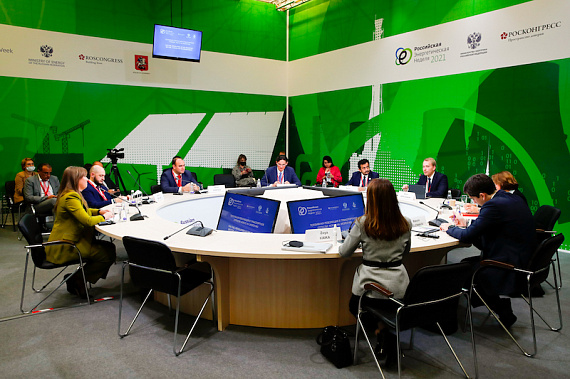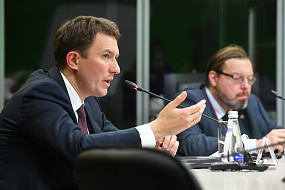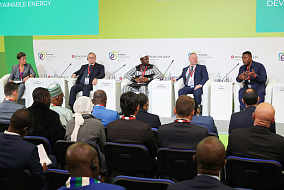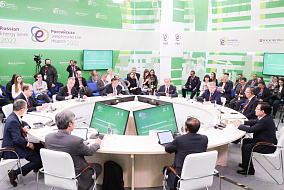The Fuel Revolution in the Transport Sector: A Focus on the Environment

KEY CONCLUSIONS
The growth of CO2 emissions is increasingly spurring society to find alternative forms of fuel and is bringing about changes in the transport industry
“The transport industry is one of the main emitters of greenhouse gases. Indeed, it accounts for 15% of the 51 billion tonnes of carbon dioxide emitted [globally – ed.]. This is spurring society to find environmentally acceptable solutions with regard to their mobility. The main revolution which is taking place before our eyes is the emergence of forms of transport which are not even new to us, but which do run on new forms of fuel, and new engines,” Denis Deryushkin, Deputy General Director – Head of Analytical Center, Russian Energy Agency of the Ministry of Energy of the Russian Federation.
“We are seeing fluctuations [in oil production volumes – ed.]; however, by 2025, there will of course be growth. And the transport industry will of course require changes accordingly,” Ayed Al-Qahtani, Director, Research Division, Organization of the Petroleum Exporting Countries (OPEC).
PROBLEMS
A lack of developed infrastructure, together with inactivity on the part of municipal authorities and the fallout from the pandemic
“Overall, the transport industry suffered greatly [as a result of the pandemic – ed.]. This is particularly true of airlines. Indeed, they sustained a drop in profits to the tune of almost 80%. Essentially, air travel ground to a halt. Even the most developed nations are experiencing problems, including those related to low vaccination rates. Overall, the transport industry has recovered to a degree; however, problems still exist,” Ayed Al-Qahtani, Director, Research Division, Organization of the Petroleum Exporting Countries (OPEC).
“Infrastructure does not just encompass petrol stations, but parking areas and many other things that specialists should consider,” Anton Rubtsov, Director of Oil Refining and Gas Complex Department, Ministry of Energy of the Russian Federation.
“At a working level, if we speak about the municipalities and specific leasing companies – not much is being done. Local authorities do not have any programmes in place to allocate land for electric charging stations. Currently about 10% of our network consists of locations we acquired via Russia’s state services portal. We have been forced to look at the remaining stations from a commercial point of view... We are treated as a commercial client, but we are only able to pay a nominal amount of a few thousand roubles. As a result, we are left with no option other than to refuse. <…> The most glaring example of this was in Kamchatka, where we were offered [to rent – ed.] land for a station for RUB 50,000 per month,” Dmitriy Belyaev, General Director, Hydroinvest; Director of Strategic Transactions Department, RusHydro.
SOLUTIONS
Building infrastructure, including an electric vehicle charging station network
“The main aim for 2030 as we see it is to put together some rules regarding electric vehicles – by 2030, at least 10% of all vehicles manufactured in the country should be electric. How should this be achieved? By building a charging infrastructure at an accelerated rate. From 2022 to 2024, RUB 8.1 billion will be allocated from the federal budget to co-finance infrastructure. We expect that this will enable targets to be met,” Maxim Kolesnikov, Director of the Department for Economic Sectors, Ministry of Economic Development of the Russian Federation.
“Large hubs should appear in the outskirts of major cities – there need to be quick charging stations at shopping centres and business centres. <...> One thing is crucial: in order not to create a technological risk threatening the stability of the electric grid, we need to build the infrastructure in places where it is most needed. We need to work in very close cooperation with municipal authorities, and take part in urban development programmes,” Konstantin Kravchenko, Acting Deputy General Director for Digital Transformation, Rosseti.
Boosting domestic demand for electric vehicles
“We are aware that today, electric vehicles <...> are more cost-efficient to drive. Of course, they are more expensive to purchase than equivalent models with a combustion engine, which is why we are setting out measures to stimulate demand and to offer discounts to the buyer. These will be offered to individuals, and on a leasing basis for up to 25% of the value of the vehicle (but not more than RUB 625,000). <...> We are also looking into the possibility of concessional loans by the Russian National Wealth Fund. And by implementing plans to localize vehicle manufacturers, we will essentially create domestic demand to create the necessary componential foundation,” Maxim Kolesnikov, Director of the Department for Economic Sectors, Ministry of Economic Development of the Russian Federation.
Greater production of alternative forms of fuel
“Today, 90% of assets have been put into operations that reduce consumption of carbon-based fuel. We are investing an enormous amount in the development of electric transport. There are around 1 million electric vehicles today, and by 2030, there will be significantly more. The market is huge. And we are focusing on charging stations. <…> Currently, we are working on new electric components which will allow batteries to operate for more than 200–300 km. We are also working on hydrogen fuel. In order for consumers to choose this and the other form of fuel, we must develop both electric engines, and hydrogen fuel engines,” Beatrice Buffon, Group Senior Executive Vice-President, International Division, EDF.
“We have not become so green over the past two years as to reject the use of oil and gas. The line goes as follows: the government is indeed supporting the development of a backbone infrastructure across all areas (as it should), and later, the private sector kicks into action. We went down this road with gas engines in 2018. We decided to provide support across all areas, but with a focus on infrastructure. We have been able to maintain the price disparity, making gas engine fuel more cost-efficient compared to petrol and diesel,” Anton Rubtsov, Director of Oil Refining and Gas Complex Department, Ministry of Energy of the Russian Federation.
Modernization of current oil refineries
“Our endeavours to develop oil refining are based not on emotion or politics, but on pure commercial interest and logic. As the figures set out in the energy development strategy for the industry make clear, demand will be fairly large. Despite the numerous forecasts, it will regardless grow off the back of motor fuel – even petrol. Even if rates slow down over the long term, or even if there’s a reduction, the period in which there will be a return on investment in modernizing oil refineries will clearly be in excess of 20 years. That is why our strategy today is to modernize all inefficient facilities, and there are special programmes in place to do so <...> It is our hope that in the near future, we will forget about terms such as ‘inefficient facilities’ in the technical sense,” Anton Rubtsov, Director of Oil Refining and Gas Complex Department, Ministry of Energy of the Russian Federation.
For more information, visit the Roscongress Foundation’s Information and Analytical System at roscongress.org/en.





